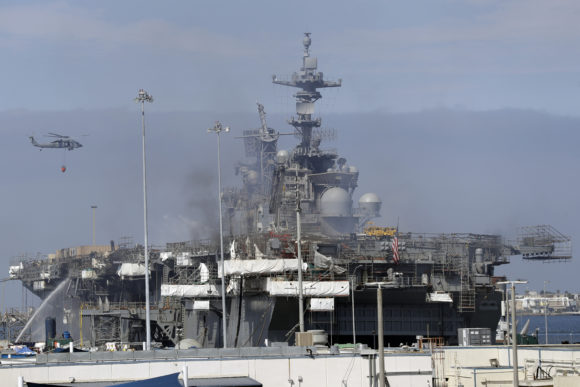SAN DIEGO — A fire aboard a U.S. warship moved away from fuel tanks, easing the threat of an explosion or a million-gallon oil spill in the San Diego harbor, but it was too early to say whether the vessel can be saved, a top Navy official said.
Days of battling flames deep within the USS Bonhomme Richard were bearing fruit and the blaze could be declared out sometime Wednesday, said Rear Adm. Philip Sobeck, commander of the strike group that includes the Bonhomme Richard as its flagship.
But he cautioned Tuesday that there was still “a major fire inside” being fought by hundreds of sailors who were focusing on two isolated spots near the ship’s bow and stern.
Fuel was stored below the waterline and the risk of it spilling or exploding was now “very low,” Sobeck said, although the U.S. Coast Guard was standing by in order to boom off any spill.
Navy officials were able to inspect four main engineering rooms and found no major damage, and the external structure of the ship appears to be safe, Sobeck said, but it was still unclear whether the 840-foot (255-meter) amphibious assault ship can be repaired.
“We haven’t been inside the ship well enough to be able to get a full picture,” Sobeck said.
It could cost the military an estimated $4 billion to replace the ship, which is akin to a mini-aircraft carrier.
The Bonhomme Richard was undergoing maintenance when the fire was first reported Sunday morning in a lower cargo area where seafaring tanks are parked. It appears to have started where cardboard boxes, rags and other maintenance supplies were being stored, Sobeck said.
The fire temperatures had reached up to 1,000 degrees Fahrenheit (538 degrees Celsius), causing a forward mast to collapse and threatening the central control island where the captain operates the vessel.
As of early Wednesday, helicopters had dumped 1,500 buckets of water on the ship, cooling the superstructure and flight deck to enable crews to move further inside the ship to fight the blaze, a Navy statement said. Federal and local firefighters also fought the blaze and tugboats threw streams of seawater from the waterline.
More than 60 sailors and civilians have been treated for minor injuries, heat exhaustion and smoke inhalation. None remained hospitalized Wednesday.
Sobeck said the ship’s design may have helped spread the blaze.
“For this class of ship, the open area above the vehicle storage is all open, a big hangar,” he said. “Once the fire hit that amount of oxygen, it found other ways to go up.”
The fire raced along the ship’s ventilation and cables, causing it to traverse the ship. Cables and duct work snaking through hatches as part of the ship’s maintenance fed the fire and later created barriers to sailors trying to fight it, Sobeck said.
Also, at least two fire-suppression systems were not able to be used. One was deactivated while the ship was being worked on, and the other was not able to be launched because of an explosion _ believed to have been caused by pressure building up when the fire started, Sobeck said.
Was this article valuable?
Here are more articles you may enjoy.


 Jump Trading Faces $4 Billion Terraform Administrator Suit
Jump Trading Faces $4 Billion Terraform Administrator Suit  Instacart to Pay $60 Million in FTC Consumer Protection Case
Instacart to Pay $60 Million in FTC Consumer Protection Case  NYT Asks Judge to Dismiss Trump’s ‘Implausible’ Defamation Suit
NYT Asks Judge to Dismiss Trump’s ‘Implausible’ Defamation Suit  J&J Talc Jury Awards $1.56 Billion to Asbestos Cancer Victim
J&J Talc Jury Awards $1.56 Billion to Asbestos Cancer Victim 